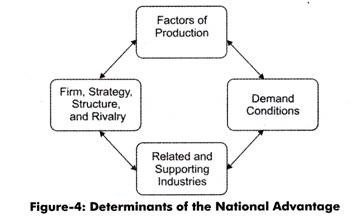Micheal Porter gave the diamond theory of national advantage, which states that the features of home country are crucial for the success of an organization in the international markets.
This theory is called the diamond theory, as it is depicted in the shape of a diamond framework.
It describes the factors that contribute to the success of organizations in global industries. These factors are called the determinants of the national advantage.
Figure-4 depicts these determinants:
The discussion of these determinants is as follows:
(a) Factors of Production:
Include the inputs necessary for producing goods and services. The basic factors to carry out a business include natural resources and labor; whereas, advanced factors include infrastructure, such as communication systems.
The skilled personnel form the part of specialized factors. If a country is endowed with all these factors of production, it would be successful in the global market. However, there may be countries that have advanced and specialized factors but lack in the basic factors.
ADVERTISEMENTS:
For example, South Korea lacks natural resources, but have specialized engineers. Thus, it can be said that the countries that lack in natural resources develop new methods or processes that lead to a national comparative advantage.
(b) Demand Conditions:
Refer to the nature and size of the customers of the products in the home market. The strong demand conditions in the home country persuade the domestic organizations to constantly improve the product. If the demand of a product is more in the domestic market then it can influence the demand of customers in the foreign market.
(c) Related and Supporting Industries:
ADVERTISEMENTS:
Involve industries in the country that are considered as the leader of a particular product. These industries help in innovation that helps organization under them to produce at low cost.
In addition, the growth of one industry influences the growth of other industries. For instance, the growth and development of the automobile industry would enhance the growth opportunities of the steel industry.
(d) Organizational Strategy, Structure, and Rivalry:
Varies from country to country. The strategies, structures, and rivalry are very important for the success of an organization. The strategies help in setting new goals, the structure helps in managing operations, and rivalry helps in generating innovative ideas in organizations.
These four determinants can also be called as the dimensions of the diamond model that help in contributing to the national advantage. According to Porter, these dimensions interact with each other and help in increasing the competitiveness of the organizations.
